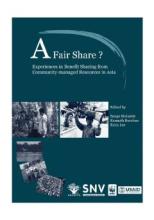Land Library Search
Through our robust search engine, you can search for any item of the over 73,000 highly curated resources in the Land Library.
If you would like to find an overview of what is possible, feel free to peruse the Search Guide.
/ library resources
Showing items 1 through 9 of 20.This book captures the main lessons and issues emerging from national and regional discussions on 'benefit sharing.' It also presents one case study from each country, selected to highlight issues in different sectors.
A collection of practical experiences and lessons on Payments for Environmental Services (PES)
This literature study, conducted under a collaborative framework between NAFRI and RECOFTC, was developed to analyze the status of community contribution to forest resource management in Lao PDR and the modes and extent that communities are or have been involved in the different applied models.
"Research, invention, and adoption of agrotechnology have played an important role in improving human nutrition and health.
"...At the moment, a lack of integration and coordination characterizes the relationship between the agriculture and health sectors. Traditionally, agricultural and health policies address specific goals within those sectors.
"Earlier briefs in this series make the case that there is added value for the agricultural and health sectors in working more closely together to address problems of human well-being that fall at the intersection of the two sectors.
"Biodiversity provides essential components of healthy environments and sustainable livelihoods.
Agriculture is fundamental to achieving nutrition goals: it produces the food, energy, and nutrients essential for human health and well-being. Gains in food production have played a key role in feeding growing and malnourished populations.
Policymaking initiatives in agriculture and public health are often pursued in a parallel and unconnected fashion. Yet coherent, joint action in agriculture and health could have large potential benefits and substantially reduce risks for the poor.









